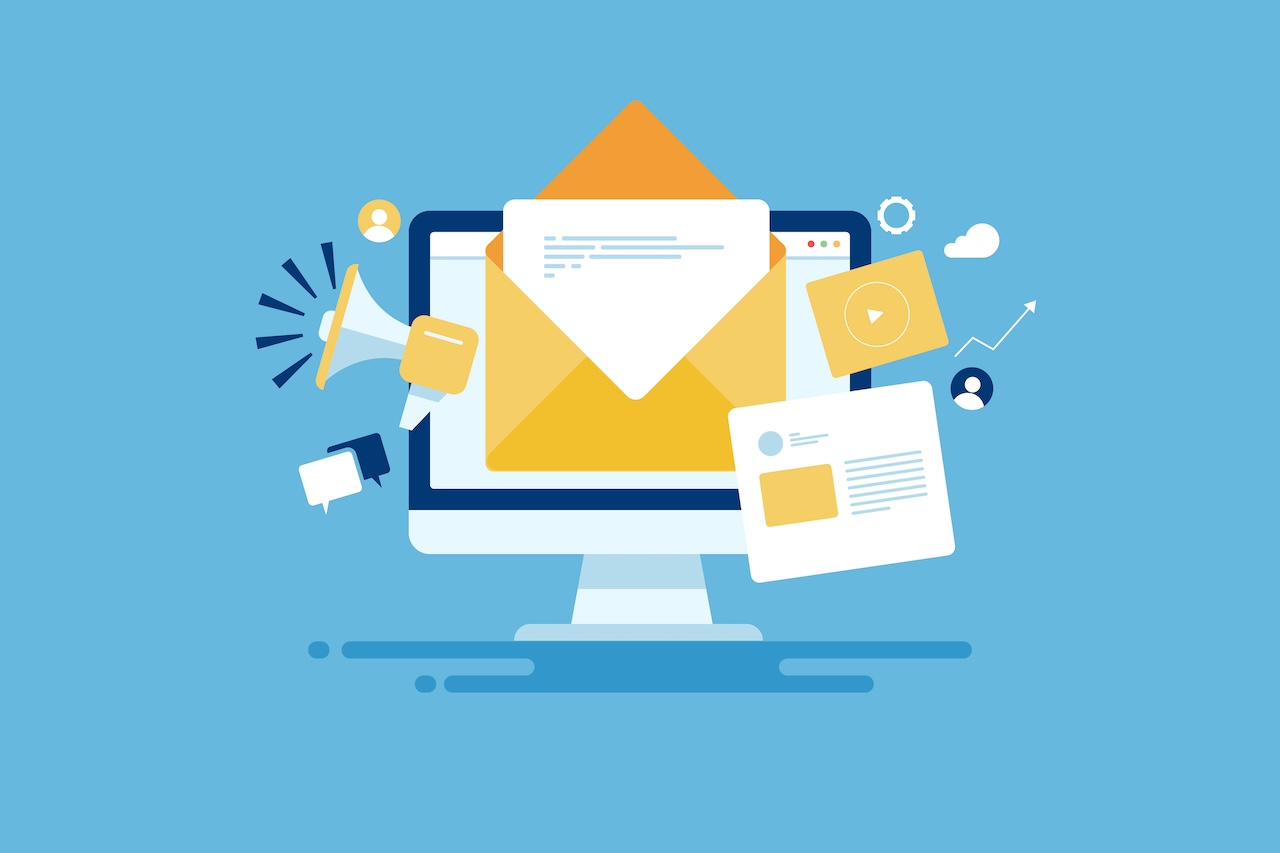Who doesn’t love the smell of fresh new IP addresses? Well, anyone charged with warming IP addresses for...
In today’s digital era, email marketing remains one of the most effective channels for reaching and engaging audiences. Despite the emergence of new communication platforms, email continues to offer unparalleled opportunities for businesses to connect with customers on a personal level, drive sales, and build loyalty. However, to unlock the full potential of email marketing, understanding and implementing best practices is crucial for a successful email marketing strategy.
The significance of following best practices in achieving email marketing success cannot be overstated. With increasing competition in their subscriber’s inboxes, marketers must adopt key strategies that not only catch the eye of their recipients but also deliver valuable and relevant content. Best practices in email marketing encompass everything from crafting compelling email subject lines and employing sophisticated segmentation techniques to embracing mobile optimization and ensuring compliance with data protection regulations.
As we delve into the what is email deliverability and specifics of email marketing best practices, keep in mind that the ultimate goal is to develop a deep connection with your audience. This requires a strategic approach that combines personalization, creativity, and a commitment to providing genuine value. By following the principles outlined in this guide, marketers can not only achieve higher engagement rates but also foster lasting relationships with their subscribers, paving the way for ongoing success in their digital marketing endeavors.

What Are The Fundamental Pillars Of Email Marketing?
Email marketing stands as a cornerstone in the foundation of digital marketing, underscored by several fundamental pillars that drive its success. To navigate the complex landscape of email campaigns, it’s instrumental to understand and master these core elements. First and foremost, a well-defined campaign strategy is crucial. This involves setting clear objectives, understanding your audience’s needs, and crafting messages that resonate and achieve your marketing goals.
Equally important is building and maintaining a healthy email list. This list is the lifeline of your email marketing efforts, enabling direct and personalized communication with your audience. However, it’s not just about quantity; the quality of your list, defined by how segmented and engaged your subscribers are, plays a pivotal role in the success of your campaigns.
Creating engaging and relevant content is another pillar. Your emails need to capture the attention of your audience amidst a sea of inbox competition. Through valuable content that speaks directly to the needs and interests of your readers, you can foster stronger relationships and drive more meaningful interactions. Catch your readers’ attention early and quickly with a snappy and concise email subject line.
In today’s mobile-first world, ensuring emails are mobile-friendly is non-negotiable. With the majority of emails being opened on mobile devices, optimization for these users is key to ensuring your messages are read and acted upon.
Finally, measuring and analyzing campaign performance through engagement metrics allows you to understand what works and what doesn’t. This insight is invaluable for refining your strategies, enhancing your content, and ultimately achieving better results with your email marketing efforts.
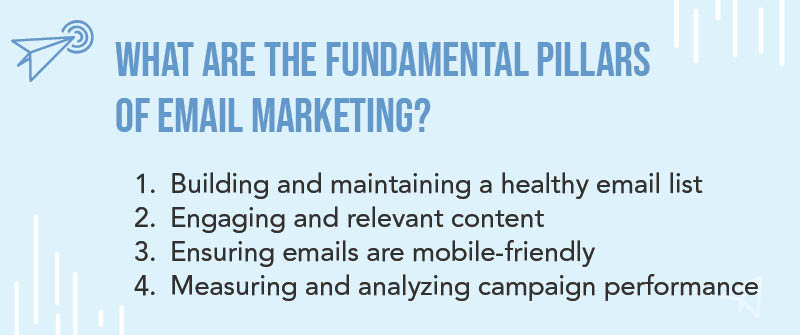
How Can You Effectively Segment Your Email List?
As email marketers, one of the most powerful tools at your disposal is list segmentation. It’s the process of dividing your email list into smaller, more focused groups based on specific criteria such as demographics, behavior, and preferences. The goal is to tailor your messaging to meet the unique needs and interests of each segment, thereby increasing the relevance and effectiveness of your campaigns.
The Benefits Of Segmentation For Targeted Messaging
Understanding the nuances and diverse interests of your audience can be challenging. However, by segmenting your list, you bring precision to your email marketing efforts. Segmented campaigns often see higher engagement rates, including opens and click-throughs, because they deliver content that’s directly relevant to the recipient. This targeted approach not only enhances the subscriber experience but also boosts your campaign’s overall performance.
Criteria For Segmenting Your List
Segmentation can be based on a variety of criteria. Demographic segmentation involves dividing your audience by age, gender, job title, or income level. Behavioral segmentation focuses on actions taken by subscribers, such as purchase history or interaction with previous campaigns. Lastly, preference segmentation is shaped by the expressed interests and needs of your subscribers, which can be gleaned from signup forms and survey responses.
Techniques for Effective Segmentation
To effectively segment your list, start with clean, well-organized subscriber data. Use analytics and engagement metrics to identify patterns and behaviors that can inform your segmentation strategy. Email marketing tools like those AudiencePoint offers provide advanced segmentation capabilities, enabling marketers to dive deeper into their data for more precise targeting.
Integrating segmentation with personalization techniques further amplifies the effectiveness of your campaigns. By understanding the specific characteristics and needs of each segment, you can craft messages that resonate on a personal level, forging stronger connections and driving higher engagement.
What Are The Key Considerations For Mobile Optimization In Email Marketing?
In today’s digitally-driven world, mobile optimization in email marketing is not just a recommendation; it’s a necessity. With the majority of emails being opened on mobile devices, marketers cannot afford to overlook the importance of responsive design. Ensuring your emails look and function great on any device is paramount to engaging your audience effectively and driving results.
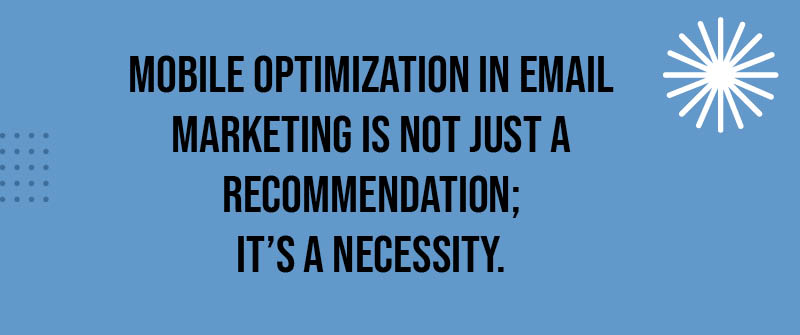
Why Mobile Optimization Matters
Mobile optimization ensures that your emails automatically adjust to the screen size and orientation of various devices. This is crucial because if an email is difficult to read or interact with on a mobile device, the subscriber is likely to delete it or unsubscribe. For email marketers, this means lost opportunities for engagement, conversion, and customer retention. Therefore, implementing responsive design is not just about aesthetics but about enhancing user experience and maximizing the effectiveness of your email marketing campaigns.
Responsive Design Principles
Achieving optimal mobile optimization begins with responsive design. This involves using fluid grids, flexible images, and media queries to create emails that look and perform well regardless of the device used to view them. Email content should be easily readable without zooming, links and buttons must be easily clickable, and the overall layout should be clean and navigable. Prioritizing these principles not only improves readability but also the user’s overall interaction with your emails.
Testing and Optimization
One cannot overstate the importance of continuous testing in ensuring your email landing pages are truly optimized for mobile devices. This involves using tools and technologies to test how emails display on different screen sizes and operating systems. Moreover, gathering and analyzing user feedback can provide insights into how to further optimize emails for mobile users. Marketers should make a habit of iterative testing and optimization as part of their regular email campaign process to keep up with evolving technologies and user preferences.
Mobile optimization is a critical component of successful email marketing. Through responsive design, thorough testing, and constantly keeping the user experience in mind, marketers can significantly improve their email campaign performance. Remember, an email well-optimized for mobile can greatly enhance engagement, conversions, and ultimately, ROI.
Why Is A/B Testing Crucial For Improving Email Campaigns?
In the dynamic world of email marketing, where user preferences and digital landscapes are constantly evolving, A/B testing emerges as a critical strategy for optimizing campaign performance. A/B testing, at its core, involves the comparison of two variations of an email to determine which performs better on a set of predefined metrics such as open rates, click-through rates, or conversions. This empirical approach provides a solid foundation for making data-driven decisions, enabling marketers to refine their campaigns with precision.

The Imperative for A/B Testing in Email Marketing
The utility of A/B testing extends beyond mere experimentation; it is a cornerstone for enhancing user engagement and campaign efficacy. By systematically evaluating different email elements—from subject lines, content, and images to call-to-actions (CTAs)—marketers can identify what resonates best with their target audience. This tailored approach facilitates a deeper connection with subscribers, potentially elevating both the immediate impact of email campaigns and long-term subscriber value.
Implementing A/B Testing: A Step-by-Step Guide
To reap the benefits of A/B testing, marketers should adopt a structured methodology, starting with the formulation of a clear hypothesis, proceeding with the selection of a significant variable to test, and culminating in the analysis of test results to inform future campaigns. Rigor in design, implementation, and analysis is paramount to isolating the effects of the variable in question and ensuring the reliability of findings.
Moreover, the lessons gleaned from A/B testing are cumulative. Over time, these insights build a rich repository of knowledge about subscriber preferences, enabling more nuanced and effective email strategies. Thus, A/B testing is not just a tactic for incremental improvement but a strategic tool for sustained excellence in email marketing.
How Does Email Personalization Enhance Subscriber Engagement?
Personalization in email marketing is more than a trend; it’s a powerful strategy that can significantly boost subscriber engagement and campaign effectiveness. In today’s cluttered inbox environment, emails that offer a personal touch stand out, fostering a stronger connection between brands and their audiences. By tailoring content to meet individual subscriber preferences and behaviors, businesses can dramatically increase their email open rates, click-through rates, and, ultimately, conversion rates.
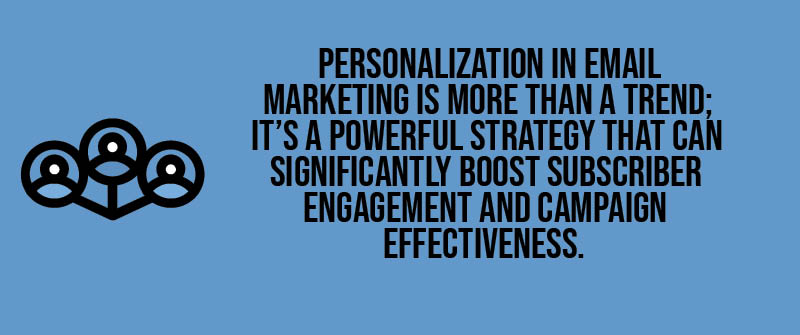
The Role of Personalization
At the heart of email personalization lies the basic principle of relevance. Subscribers are more likely to engage with emails that reflect their specific interests, needs, and past interactions with a brand. This relevance is achieved by leveraging data insights to create email content that feels bespoke to each recipient. The result is a heightened sense of value in the eyes of the subscriber, which directly translates to improved engagement metrics.
Strategies Beyond Names
While addressing subscribers by name is a well-known personalization tactic, modern email personalization strategies delve much deeper. Advanced techniques include segmenting email lists based on purchase history, browsing behavior, or engagement level, thereby allowing emails to cater to the position of a subscriber within the customer journey. Personalized product recommendations, tailored content offerings, and exclusive invitations to events are just a few examples of how deep personalization can enhance the subscriber experience.
Leveraging User Data
The effective use of user data is central to personalizing email content. By analyzing engagement patterns, such as the times when subscribers are most likely to open emails or the types of content they engage with, email marketers can create highly targeted campaigns. The goal is not just personalized communication but contextual relevance—sending the right message to the right person at the right time. With today’s technology, dynamic content can be automatically adjusted for each subscriber, ensuring every email feels specially crafted for its recipient.
What Are The Best Practices For Ensuring Data Protection And Privacy?
In today’s digital landscape, data protection and privacy are paramount, especially within the realm of email marketing. With rigorous laws such as the General Data Protection Regulation (GDPR) in the European Union and the CAN-SPAM Act in the United States, marketers must navigate a complex legal framework to ensure compliance. But beyond mere compliance, establishing trust with your subscribers through robust data protection practices can significantly elevate your brand’s reputation and subscriber engagement.
Understanding Key Regulations
At the forefront of ensuring data protection is a thorough understanding of the laws that govern email marketing. The GDPR, for example, mandates explicit consent for collecting and using personal data, among other requirements. Similarly, the CAN-SPAM Act regulates how commercial emails are sent, including the necessity for a clear way to opt-out of receiving future emails. Familiarizing yourself with these and other relevant regulations is the first step in crafting an email marketing strategy that respects privacy while engaging your audience.
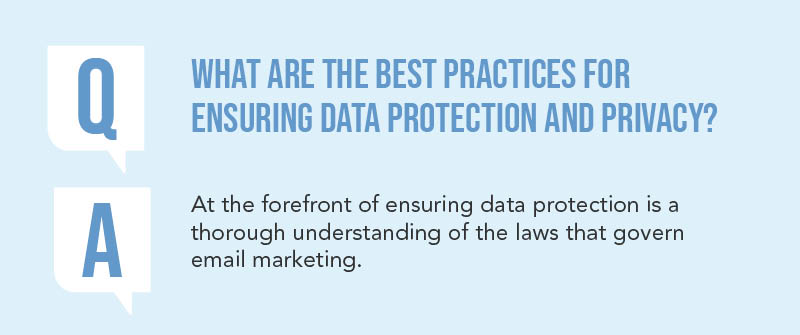
Implementing Best Practices for Data Management
Collecting subscriber data is a responsibility that requires meticulous attention to detail. Best practices include obtaining clear consent at the point of data collection, transparently communicating how you intend to use their data, and ensuring secure storage and handling of personal information. Regular audits of your data collection and storage methods can also help identify potential vulnerabilities in your system, thereby preventing breaches before they occur.
Forging Trust Through Transparency
Building a relationship with your subscribers doesn’t just revolve around the content of your emails; it also hinges on how you manage their data. Demonstrating a commitment to data protection through transparent practices fosters trust. This can include detailed privacy policies, regular updates about data use, and quick responses to any data-related inquiries. In an era where data breaches are all too common, a transparent approach to data protection can set your brand apart.
Email Authentication: Using DKIM, DMARC, and SPF
Email authentication protocols like DomainKeys Identified Mail (DKIM), Domain-based Message Authentication, Reporting, and Conformance (DMARC), and Sender Policy Framework (SPF) are essential for protecting both your brand and your subscribers. These protocols help prevent email spoofing and phishing by verifying that the emails you send are genuinely from you. Implementing these measures can significantly help maintain high email delivery and bolster your sender reputation.
How Do You Measure The Success Of Your Email Marketing Campaigns?
Determining the return on investment (ROI) of your email marketing efforts is crucial to understanding its effectiveness and making data-driven decisions for future campaigns. The key to this lies in the strategic use of engagement metrics. By closely monitoring these metrics, digital marketers can gain insights into how subscribers interact with their emails and adjust their strategies accordingly for optimum performance.
Key Metrics to Track
The cornerstone of successful email marketing campaign analysis is identifying which metrics are the most indicative of your campaign’s performance. The primary metrics to focus on include the open rate, click-through rate (CTR), and conversion rate. Open rate measures how many people open your emails, serving as an initial gauge of your email’s appeal.
While open rate has been used extensively throughout the history of email marketing, with the advent of Apple’s MPP technology, opens are, at best, a directional metric. The CTR tells you the percentage of email recipients who clicked on one or more links contained in an email, which helps assess the effectiveness of your email content and calls to action. Lastly, the conversion rate tracks how many of those clicks translated into a desired action, such as a purchase or signup, directly correlating email marketing efforts with your bottom line.

Tools and Technologies for Measurement
In an era where data is king, leveraging advanced tools and technologies for measuring email campaign performance is non-negotiable. From email marketing platforms that provide analytics dashboards to sophisticated marketing automation tools capable of tracking a user’s journey across emails and websites, choosing the right technology stack can significantly enhance your measurement capabilities. Integrating email marketing software with your CRM or sales database allows for a more comprehensive view of how email marketing influences customer behavior and business outcomes.
Using Insights from Data Analysis
Merely tracking metrics is not enough; translating data into actionable insights is where the real value lies. By analyzing performance data, email marketers can identify trends, test hypotheses (using techniques like A/B testing), and iteratively improve their email campaigns. For instance, if an analysis reveals a declining open rate, it might be time to refresh your subject line strategies or segment your list more effectively. Conversely, a spike in unsubscribe rates could indicate issues with email frequency or relevance. Ultimately, the goal is to use these insights to refine your email marketing strategy, ensuring every campaign is more successful than the last.
Key Takeaways For Email Marketing Best Practices
As we wrap up this comprehensive journey through the landscape of email marketing best practices and email marketing campaign examples, it’s clear that the potential for impact and innovation within this domain is immense. Through strategic campaign planning, detailed list segmentation, meticulous mobile optimization, continuous A/B testing, personalized messaging, staunch data protection, and diligent monitoring of engagement metrics, businesses can set a strong foundation for their email marketing efforts.
In today’s rapidly evolving digital arena, the principles of email marketing remain fundamentally anchored in understanding and respecting your audience’s preferences and privacy. The beauty of email marketing lies in its ability to foster a direct and personalized connection with your subscribers, making it a crucial tool in your digital marketing arsenal.

However, the landscape of email marketing is continually changing, with new trends, technologies, and tactics emerging regularly. Staying ahead requires not just adherence to best practices but also an eagerness for continuous learning, experimentation, and adaptation. As email marketers and digital marketing professionals, your journey towards mastering email marketing is perpetual, filled with opportunities to refine your strategies and achieve greater success.
In light of this, we encourage you not to view the end of this guide as the conclusion of your learning but as a stepping stone toward greater innovation and excellence in your email marketing campaigns. Embrace the principles outlined, experiment with new ideas, and continuously seek out ways to enhance your engagement and conversion rates.
Transform your email marketing with AudiencePoint. Gain unparalleled insights into subscriber habits with our extensive data pool, tracking 85 trillion engagements. Boost your deliverability, re-engagement, and revenue with our advanced platform. Let us partner with you in your quest for email marketing mastery, offering the tools and insights needed to ensure your email campaigns achieve unprecedented success. Contact AudiencePoint today!
